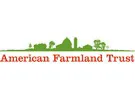American Farmland Trust (AFT), the organization behind the national “No Farms No Food” movement released “Farms Under Threat, A New England Perspective” at its February 19th Food, Farms, Fisheries, and Forests: Diet, Climate, Conservation, and a Healthy Future for New England conference, sponsored by The Harvard Pilgrim Health Care Foundation. The report details AFT’s ground-breaking analysis of New England’s farmland and its farmers’ enterprises, showing threats to the land, its people, and its food production. It outlines opportunities to bolster conservation and build resiliency for healthy and sustainable food production for the future.
For 40 years, AFT has worked to arrest the growing encroachment of development on the country’s farmland. Its “Farms Under Threat, A New England Perspective” report details the recent and rapid loss of many states’ most productive, versatile, and resilient land. In New England, 177,000 acres of farmland are in the path of development and 20 percent of farmland is in the path of floodwaters. Combined with a changing climate, soaring land prices, volatile commodity markets, and an aging farming population, the report details how farm viability faces growing risks.
“Farming is under mounting pressure from a growing population and a changing climate—and we need our farmland to both grow food and provide essential environmental services, including carbon sequestration,” said John Piotti, President and CEO of American Farmland Trust. “Here in New England, we face an urgent need to save far more farmland, transition to regenerative practices, and bring new farmers on the land as older farmers retire. This report underscores the need for action, and we appreciate the shared vision of our partner Harvard Pilgrim Health Care in helping us amplify our findings.”
Despite New England having one of the longest and deepest commitments to easement-based protection efforts, it has not embraced some of the most valuable land-use planning tools to slow down development on farmland. The report recommends immediate actions for policymakers, thought leaders, and funders to improve land conservation, equitable land access, and food security, which can ultimately impact public health and wellness.
“Farms, fisheries and forests are amongst our most important public health resources,” said Karen Voci, President of the Harvard Pilgrim Health Care Foundation. “We are proud to support this conference which showcases the urgent need for transformative land protection policy to reduce the effects of climate change and increase our access to healthy and sustainable food.”
“Farms Under Threat, A New England Perspective” maps farmland at the census track level and provides important insights into the challenges faced by farmers and the farming industry:
- In New England between 2001 and 2016 over 105,000 acres of open farmland were developed, fragmented, or converted to other uses. That’s more than 19 acres every day. Two-thirds of that total (68,000 acres) fall into a new category of threat that has never been mapped and documented before: “low-density residential development,” or “LDR”.
- Eighty-five percent of New England’s farmland is unprotected. While current farmland protection programs are essential and should be expanded, they alone will never do all we need; at the current pace, it would take 350 years and $10 billion to protect New England’s remaining farmland.
- With rising land prices and volatile commodity markets, small and part-time farms that comprise two-thirds of New England’s farms face greater risk than larger farms.
- Climate change poses imminent threats to New England agriculture, yet if our farms implemented just three widely-accepted conservation practices (planting cover crops, practicing no-till or strip till, and replacing inorganic fertilizer with dairy manure or compost), we could annually mitigate 1.65 million metric tons of carbon dioxide from the atmosphere, the equivalent of taking 360,000 cars off the road each year.
- According to the 2017 Census of Agriculture, 61 percent of New England’s food producers are over the age of 55, with nearly a third of all producers over the age of 65.
- While there has been a 50% increase in non-white farmers, minority farmers control only 2% of the agriculture land base.
For more information: American Farmland Trust
American Farmland Trust
www.farmland.org
